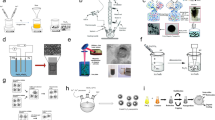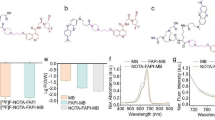Abstract
Optical technologies are evolving in many biomedical areas including the biomedical imaging disciplines. Regarding the absorption properties of physiological molecules in living tissue, the optical window ranging from 700 to 900 nm allows to use fluorescent dyes for novel diagnostic solutions. Here we investigate the potential of two different carbocyanine-based dyes fluorescent in the near infrared as contrast agents for in vivo imaging of subcutaneously grown tumours in laboratory animals. The primary aim was to modify the physicochemical properties of the previously synthesized dye SIDAG to investigate the effect on the in vivo imaging properties.
Similar content being viewed by others
Abbreviations
- CCD:
-
charge-coupled device
- MRI:
-
magnetic resonance imaging
- NIR:
-
near infrared
References
E. E. Graves, R. Weissleder, and V. Ntziachristos (2004). Fluorescence molecular imaging of small animal tumor models. Curr. Mol. Med. 4, 419–430.
J. P. Houston, A. B. Thomson, M. Gurfinkel, and E. M. Sevick-Muraca (2003). Sensitivity and depth penetration of continuous wave versus frequency-domain photon migration near-infrared fluorscence contrast-enhanced imaging. Photochem. Photobiol. 77, 420–430.
B. Ebert, U. Sukowski, D. Grosenick, H. Wabnitz, K. T. Moesta, K. Licha, A. Becker, W. Semmler, P. M. Schlag, and H. Rinneberg (2001). Near-infrared fluorescent dyes for enhanced contrast in optical mammography: Phantom experiments. J. Biomed. Opt. 6, 134– 140.
M. A. Francescini, K. T. Moesta, S. Fantini, G. Gaida, E. Gratton, H. Jess, W. W. Mantulin, M. Seeber, P. M. Schlag, and M. Kaschke (1997). Frequency-domain techniques enhance optical mammography: Initial clinical results. Proc. Natl. Acad. Sci. USA 94, 6468–6473.
L. Goetz, H. Heywang-Koebrunner, O. Schuetz, and H. Siebold (1998). Optische Mammographie an praeoperativen Patientinnen. Acad. Radiol. 8, 31–33.
D. Grosenick, H. Wabnitz, H. Rinneberg, K. T. Moesta, and P. M. Schlag (1999). Development of a time-domain optical mammograph and first in vivo applications. Appl. Opt. 38, 2927–2943.
D. Grosenick, K. T. Moesta, H. Wabnitz, J. Mucke, Ch. Stroszynski, R. MacDonald, P. M. Schlag, and H. Rinneberg (2003). Time-domain optical mammography: Initial clinical results on detection and characterization of breast tumors. Appl. Opt. 42, 3170– 3186.
V. Ntziachristos and R. Weissleder (2002). Charge-coupled-device based scanner for tomography of fluorescent near-infrared probes in turbid media. Med. Phys. 29(5), 803–809.
X. Li, B. Beauvoit, R. White, S. Nioka, B. Chance, and G. Yodh (1995). Tumor localization using fluorescence of indocyanin green (ICG) in rat models. SPIE 2389, 789–798.
J. S. Reynolds, T. L. Troy, R. H. Mayer, A. B. Thompson, D. J. Waters, K. K. Cornell, P. W. Snyder, and E. M. Sevick-Muraca (1999). Imaging of spontaneous canine mammary tumors using fluorescent contrast agents. Photochem. Photobiol. 70, 87–94.
S. Zhao, M. A. O’Leary, S. Nioka, and B. Chance (1995). Breast tumor detection using continuous wave light source. SPIE 2389, 789–798.
M. M. Haglund, M. S. Berger, and D. W. Hochmann (1996). Enhanced optical imaging of human gliomas and tumor margins. Neurosurgery 38, 309–317.
C. M. Leevy, F. Smith, J. Longuevill, G. Paumgartner, and M. M. Howard (1967). Indocyanine green clearance as a test for hepatic function. Evaluation by dichromatic ear densitometry. J. Am. Med. Assoc. 200, 236.
R. W. Flower and B. E. Hochheimer (1976). Indocyanine green dye fluorescence and infrared absorption choroidal angiography performing simultaneously with fluorescein angiography. John Hopkins Med. J. 138, 33–42.
G. Paumgarten, P. Probst, K. Kraines, and C. M. Leevy (1970). Kinetics of indocyanine green removal from the blood. N. Y. Acad. Sci. 170, 134–114.
D. K. F. Meijer, B. Weert, and G. A. Vermeer (1988). Pharmakokinetics of biliary excretion in man. VI. Indocyanine green. Eur. J. Clin. Pharmacol. 35, 295–303.
K. Licha, B. Riefke, V. Ntziachristos, A. Becker, B. Chance, and W. Semmler (2000). Hydrophilic cyanine dyes as contrast agents for near-infrared tumor imaging: Synthesis, photophysical properties and spectroscopic in vivo characterization. Photochem. Photobiol. 72, 392–398.
P. Dawson (1996). X-ray contrast-enhancing agents. Eur. J. Radiol. 23, 172–177.
A. N. Oksendal and P.-A. Hals (1993). Biodistribution and toxicity of MR imaging contrast media. JMRI 1, 157–165.
S. Mordon, J. M. Devoiselle, S. Soulie-Begu, and T. Desmettre (1998). Indocyanine green: Physisochemical factors affecting its fluorescence in vivo. Microvasc. Res. 55, 146–152.
T. Desmettre, J. M. Devoiselle, and S. Mordon (2000). Fluorescence properties and metabolic features of indocyanine green (ICG) as related to angiography. Surv. Opthalmol. 45, 15–27.
X. Intes, J. Ripoll, Y. Chen, S. Nioka, A. G. Yodh, and B. Chance (2003). In vivo continuous-wave optical breast imaging enhanced with indocyanine green. Med. Phys. 30, 1039–1047.
V. Ntziachristos, A. G. Yodh, M. Schnall, and B. Chance (2000). Concurent MRI and diffuse optical tomography of breast after indocyanine green enhancement. PNAS 97, 2767–2772.
J. R. Less, M. C. Posner, Y. Boucher, D. Borochovitz, N. Wolmark, and R. K. Jain (1992). Interstitial hypertension in human breast and colorectals tumors. Cancer Res. 52, 6371–6374.
Author information
Authors and Affiliations
Corresponding author
Rights and permissions
About this article
Cite this article
Perlitz, C., Licha, K., Scholle, FD. et al. Comparison of Two Tricarbocyanine-Based Dyes for Fluorescence Optical Imaging. J Fluoresc 15, 443–454 (2005). https://doi.org/10.1007/s10895-005-2636-x
Received:
Accepted:
Issue Date:
DOI: https://doi.org/10.1007/s10895-005-2636-x




